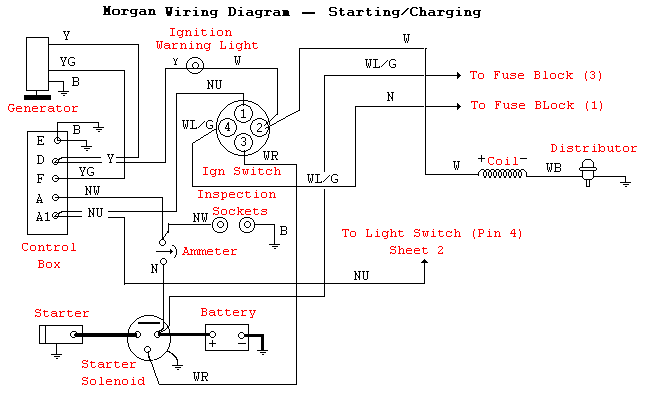Theory of Operation
©By: Gerry Willburn
Formatted by John T. Blair
Originally written: Circa 2000
Last updated: June 17, 2009 - Reformatted page
Gerry originally wrote this as a reply to an email question on the subject. It is provided on SOL's Morgan Web page with his permission.
While it was written particularlly for the Morgans, the general theory is valid for most cars.
(ED: The ignition light is used to tell when a generator (or alternator) is charging the battery. When the light is on, it means that you are running off the battery or discharging the battery. When the engine is started and the speed of the generator is sufficient, the light will go out, indicating that you are not running off the battery. The generator is doing it's job and charging the battery at least as much as is being drained. At very low engine rpms - like at idle - the ignition light may flicker or glow dimly. This indicates that the generator is just not charging enough.)

When the output of the generator is lower than the voltage of the battery, the light will be on. The current path is from the battery through the light, through the generator to ground then back to the other side of the battery (the battery is "charging" the generator). When the output of the generator rises to the level of the battery, the light goes out.
There are two conditions where the light could be on while the generator is working. Both involve the generator output being MUCH higher than the battery voltage.
In the first instance the "dropout relay" (inboard coil on the regulator) has not picked up. The Open circuit voltage from the generator will generally be in the range of 16V to 18V depending on the setting of the regulator. This is most likely not the case as he says the ammeter indicates the battery is charging.
The second instance requires that the charging rate setting of the regulator (outboard relay) be set MUCH too high (or uncontrolled). If there is enough resistance in the charging system the generator output can become enough higher than the battery to cause the light to come on. The charging rate should be adjusted on the regulator after swapping battery polarity.
There is also, I suppose the possibility that one side of the light is connected to ground and not where it is supposed to be. If the yellow wire is grounded instead of being connected to the generator output, the light will come on when the ignition is turned on (as normal) and then will get brighter as the generator connects to the battery. This would be exaggerated by a low battery. If the white wire on the lamp is grounded instead of being connected to the ignition switch, the lamp will be out when the ignition is first switched on and then vary in brightness directly with generator output.
Assuming the lamp worked properly before the switch to negative ground, and the system seems to be otherwise working, it is most likely the case that the charging rate of the regulator is set too high.
(ED. Gerry's article deals with why and how the light works. Let me
change the tack here and address another point.
Suppose the charging system is
Check the ignition light bulb. In many instances, this light provides the
trickle charge to get the generator charging.)
Return to the Index of Tech. articles
To email me with comments or questions.